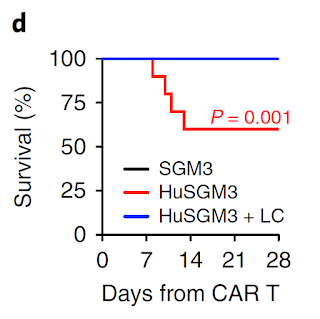Tumor immunotherapy with checkpoint inhibitors (anti-CTLA-4, anti-PD1/PDL1 antibodies) showed remarkable therapeutic effect in narrow slice of cancer patients (~20% - 25% of cases). It relies on reactivation of tumor infiltrating T cells called TILs (tumor-infiltrating lymphocytes). Obviously, the more we know about nature of these TILs the better medical approaches could be implemented.
A new study in Nature Medicine by Ton Schumacher's group in Netherlands analyzed single cell sorted TIL TCR specificity derived from 4 treatment-naive patients. Their limited and [technically inadequate, in my view] analysis revealed that tumor specific T cells represent a minor population among TILs from such cancers as ovarian cancer (OVC) and microsatellite stable colorectal cancer (CRC).
First, the authors validated their approach with T cells derived from melanoma samples. 88 CD8+ TILs were single cell sorted, TCR sequenced and TCR α/β chain pairs established. 15 such TCR pairs were trasduced into primary T cells and exposed to melanoma samples. 9 different TCR transduced T cells showed IFN-γ expression (60%). It is not clear what tissue they used as non-melanoma negative samples. They mentioned B cells in methods section though it is not obvious why would B cells act as a good negative samples for skin tissue. Also, I find it highly inadequate to limit tumor antigen-specificity detection to intracellular IFN-γ expression when using primary T cells as a TCR transduction carrier. Based on TCR affinity it might engage other types of response.
With these caveats in mind lets examine their results. When they tested single cell sorted TIL TCRs derived from ovarian cancer sample (from a single patient, OVC21), out of 20 TCR transduced T cells only 1 TCR showed IFN-γ response to tumor tissue. Another patient's TCR assay showed zero reactivity. Again, it is not clear whether low reactivity is a biological effect or simply technical deficiency as discussed earlier. We cannot even be sure whether that 1 TCR is actually tumor specific either. It also appears that pairing of TCR α/β chains is not a straightforward either because out of 95 sorted cells only 37 (39%) TCRα/β pairs could be identified.
A slightly more encouraging results were obtained with TCRs from one CRC sample (patient CRC11). Here 5 out 16 TCR tested showed IFN-γ response to cancer organoid tissue. however, similar test on another patient's TCRs showed zero response.
In summary, this study tried to show [but utterly failed in my view] that for some tumors tumor-reactive TCRs among TILs are quite rare. What are then such TILs' TCR specificity are unknown. Why are they recruited in tumor tissue is not known either. The authors have not even formally tested what neoantigens, if any, these tumors from those 4 patients actually expressed. Very unsatisfactory study.
posted by David Usharauli
With these caveats in mind lets examine their results. When they tested single cell sorted TIL TCRs derived from ovarian cancer sample (from a single patient, OVC21), out of 20 TCR transduced T cells only 1 TCR showed IFN-γ response to tumor tissue. Another patient's TCR assay showed zero reactivity. Again, it is not clear whether low reactivity is a biological effect or simply technical deficiency as discussed earlier. We cannot even be sure whether that 1 TCR is actually tumor specific either. It also appears that pairing of TCR α/β chains is not a straightforward either because out of 95 sorted cells only 37 (39%) TCRα/β pairs could be identified.
A slightly more encouraging results were obtained with TCRs from one CRC sample (patient CRC11). Here 5 out 16 TCR tested showed IFN-γ response to cancer organoid tissue. however, similar test on another patient's TCRs showed zero response.
In summary, this study tried to show [but utterly failed in my view] that for some tumors tumor-reactive TCRs among TILs are quite rare. What are then such TILs' TCR specificity are unknown. Why are they recruited in tumor tissue is not known either. The authors have not even formally tested what neoantigens, if any, these tumors from those 4 patients actually expressed. Very unsatisfactory study.
posted by David Usharauli

















































